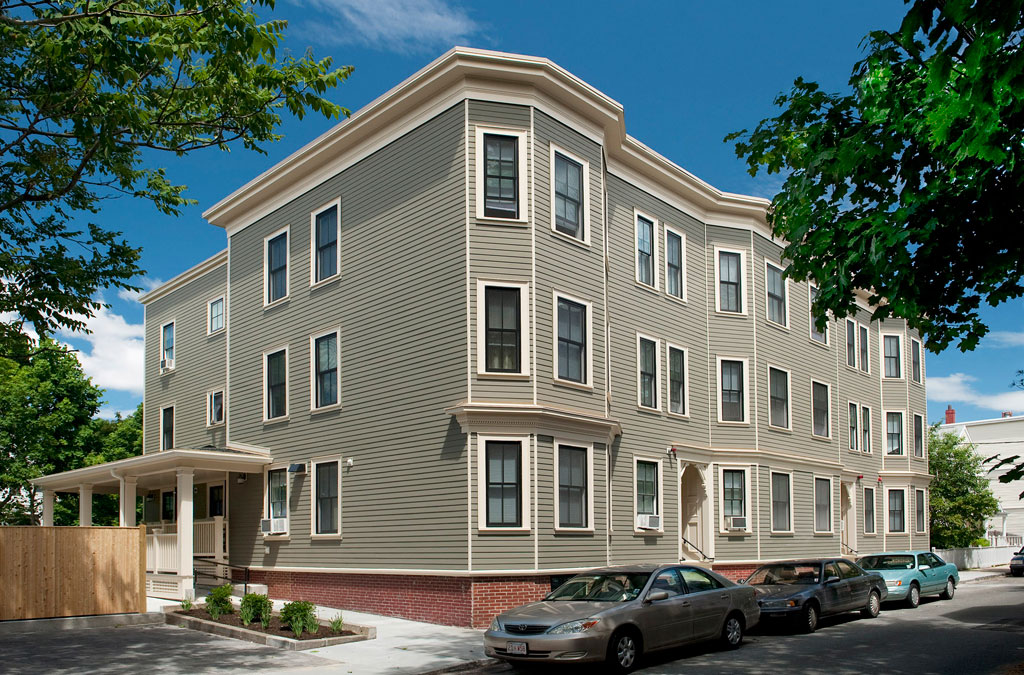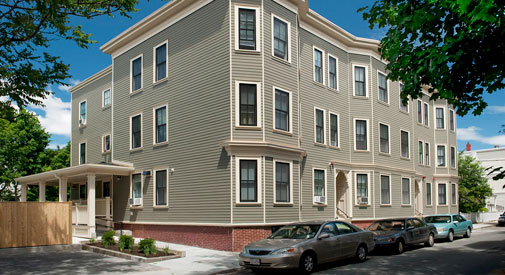Benefits of a proposed overlay outweigh risks, and affordable housing is always controversial

Homeowners Rehab Inc. built this affordable-housing project referred to as CCHDI. (Photo: Icon Architecture)
Since serving five City Council terms years ago, I have not commented publicly on many municipal issues. But as someone who has fought for affordable housing throughout my career, I am writing now in strong support of the proposed affordable housing overlay zoning ordinance, because it will mean so much for the future of Cambridge.
![]() Every recent survey of Cambridge residents shows that affordable housing is by far our most important concern. And for good reason: When rent control ended in 1995, Cambridge lost about 14,000 affordable apartments. Since then, our percentage of legally protected affordable housing has decreased even further, from 15.4 percent in 1997 to 14.7 percent in 2016. Partly as a result, from 2009 to 2015, single-family home prices here rose by 76 percent, two-family home prices by 70 percent and condominium prices by 36 percent; rents rose by 59 percent for one-bedroom apartments, 63 percent for two-bedroom apartments and 81 percent for three-bedroom apartments (all adjusted for inflation). Over that same period, Boston-area inflation-adjusted median household income rose only 2.6 percent. Cambridge is increasingly a place where only wealthy people can afford to live.
Every recent survey of Cambridge residents shows that affordable housing is by far our most important concern. And for good reason: When rent control ended in 1995, Cambridge lost about 14,000 affordable apartments. Since then, our percentage of legally protected affordable housing has decreased even further, from 15.4 percent in 1997 to 14.7 percent in 2016. Partly as a result, from 2009 to 2015, single-family home prices here rose by 76 percent, two-family home prices by 70 percent and condominium prices by 36 percent; rents rose by 59 percent for one-bedroom apartments, 63 percent for two-bedroom apartments and 81 percent for three-bedroom apartments (all adjusted for inflation). Over that same period, Boston-area inflation-adjusted median household income rose only 2.6 percent. Cambridge is increasingly a place where only wealthy people can afford to live.
So we need to do everything we can to protect the future affordability and diversity of our city. The affordable housing overlay is an important way to do that: It will give small height and density bonuses for new housing that will be permanently 100 percent affordable to low- and middle-income Cambridge residents. It will help our trusted affordable housing developers compete for available land in ways that they usually cannot now. It will expand opportunities for affordable housing development in all neighborhoods, combating the racist legacy of redlining that excluded people of color from the “best” areas. And it will fight climate change and reduce “super commutes” by allowing more people to live near where they work and around transit stops.

The overlay is controversial; affordable housing usually is, in my experience. Opponents claim that unsightly new housing will destroy neighborhood character. But the proposal would allow only a single additional floor of height in residential neighborhoods, where the vast majority of buildings are already “non-conforming” because they were built before present zoning restrictions. City staff predicts (perhaps unfortunately) that due to limited financing, the overlay will produce at most 100 affordable housing units citywide every year. Our affordable housing developers have a consistent, exemplary record of design that fits nicely into existing neighborhoods, and the overlay contains design guidelines that will ensure that. The overlay also maintains all the city’s existing protections for historic structures, including the neighborhood conservation district ordinance I sponsored when I was a councillor.
Opponents also complain that the overlay reduces the Planning Board’s role. But that is necessary to avoid binding, discretionary review of every affordable housing development, which unfortunate experience shows inevitably prevents timely land acquisition and produces yearslong litigation that kills project financing. Still, the overlay requires extensive citizen participation, including robust Planning Board involvement and advice. And the city’s Affordable Housing Trust will play an important role by approving funding only for appropriate developments.
The overlay is an innovative proposal developed by the city’s excellent professional planning staff. Like any new idea, it presents some small risks – maybe a design not to some neighbor’s liking, or an unwelcome shadow on an abutter’s yard. These risks pale when compared with the risks of no action or longer delay: more Cambridge families living on the streets, or in cars, or crowded in with relatives, or forced to move far away from their jobs and their friends. As a single-family homeowner who has had the incredible privilege of raising my family for 28 years in a Residence B zone, I am eager to accept those small risks – which the overlay does everything to minimize – in return for putting a roof over the heads of new and old neighbors and saving the affordable, diverse, vibrant Cambridge that I love.

One fascinating outcome of the overlay debate has been the other housing proposals it has inspired. Some of these are good ideas that we should pursue. For example, the City Council recently passed unanimously a little-noticed zoning change making it easier to permit “accessory dwelling units,” sometimes called in-law apartments, that could provide hundreds of additional naturally affordable housing units citywide. And certainly, the city should publicly encourage the universities and other major employers to fund more housing – but our legal power to mandate this is limited to the “linkage” and “inclusionary” requirements for new private development that the council has already enacted.
Other ideas do not really address the need for more affordable housing. Providing rental or homebuyer subsidies – whether by direct city appropriation or through tax incentives (the latter requiring unlikely state legislative approval) – would simply bid up housing prices unless we also dramatically increase the number of allowed housing units, thus actually hurting residents who do not get these subsidies. And while I continue to support reasonable rent, eviction and condo-conversion controls and other methods to protect tenants against displacement, they would regrettably allocate only a shrinking number of affordable apartments in the face of increasing demand, and most of these remedies also require state legislative action that seems very unlikely soon.
Some overlay opponents propose alternatives intended to head off the prospect of new affordable housing in their neighborhoods. But even their good ideas should be in addition to, not instead of, the overlay. The overlay proposal has been the subject of more citizen participation than I have seen in my lifetime: five city-sponsored neighborhood open houses, two Planning Board public hearings, vigorous debate in our newspapers, neighborhood listservs and online forums, and at least four council public hearings, with more to come. No doubt our council will improve it further before voting on it in September, and I welcome ideas to do that.
The Affordable Housing Overlay is not a panacea, and it will not solve all our affordable housing problems. But it is an important tool to address those problems. It is the only one ready to enact that actually increases Cambridge’s affordable housing supply. I hope the Council will pass it soon.
David E. Sullivan is a former Cambridge city councillor and a resident of Notre Dame Avenue in North Cambridge.


I certainly agree that exploring options for affordable housing is a good idea and I respect David Sullivan’s work. I do wonder where the statistics on rents and income are from. It seemed at odds with what I thought the trend was, so I looked up Census Data, from the American Community Survey, which seems to be a good source of information. That data on median income and rental are different. I wonder if the data in the article shows something different since the housing prices are for Cambridge, but the income for the Boston area, which have historically been quite different.
The ACS census data shows for BOSTON the median rent increased (doesn’t breakdown different size apartments) 43.3% from 2005 to 2017, and Cambridge median rent increased 66.2%. During that same time, 2005-2017 – Median household income for Boston went up 59.4%, and in Cambridge increase was 83.4%. [BOTH Numbers are overall, not adjusted for inflation.] I certainly believe there is an affordable housing emergency – nationwide. However, it is important to use the best data sources when assessing the situation. Is there a better source that is equally comprehensive than the ACS census data?
https://factfinder.census.gov/faces/tableservices/jsf/pages/productview.xhtml?pid=ACS_17_1YR_S2503&prodType=table
The housing price and rent data are from the Cambridge Community Development Department’s Housing Profile,
https://www.cambridgema.gov/~/media/Files/CDD/FactsandMaps/profiles/demo_profile_housing_2016.pdf
(which I adjusted for inflation). Inflation-adjusted Boston-area median household income data 2009-2015 are from this summary of ACS data: https://www.deptofnumbers.com/income/massachusetts/boston/
Thanks David for the sources. Using the same source for both if possible makes more sense and is less prone to error. That is what I did – the data for both income and rents are from the ACS – which presumably is a much more comprehensive data set than the CDD data. The CDD citation states data is from surveys of realtors, and craigslist, and a review of ads. Those sources are not complete and is the type of clear market data needed. The ACS source, which you use for income, should also be used for rents. And doing that the disparity between median rental increase and income increase is not nearly as large.
Your point about increasing income disparity is quite on point, and a real concern for all.
It is important to note, as the CDD report you cite confirms, that the actual NUMBER of affordable units went UP even the last few years, as the % dipped slightly. Since the city continues to build, the number of affordable units now is much higher than 20 years ago. I also wanted to note that you mentioned “losing” 14,000 affordable units due to rent control. Those units may have been more affordable, but none were means tested units, and very few were low income tenants. When rent control ended, any low income tenant in a unit automatically got an extension yet very few people qualified for it.